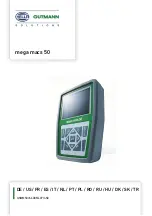
ML4000
User Guide
31
Using the Dual Inputs.
The 2 (6 optional) stereo channels let you connect
up to 4 (12 optional) stereo sources. Two sources
may be plugged into each channel strip. Either may
be selected or both can be mixed together as a
common source.
The possibilities are endless. The advantage is that
you can connect many stereo sources without
wasting channels. Here are a few examples:
Effects Returns
. Typical application of the stereo
channels is to return the processed output from
effects devices such as reverb and multi-effects
units. With full routing available you can send the
effects to the main mix, groups and auxes as
required. The LCRplus panning lets you position
the stereo return in the 3 speaker mix, for example
reverb mostly to LR with a little blended to C. Too
much returned to C may affect intelligibility. The
signal routes in stereo to LR but sums into mono
when blended to C.
To save channels you could return two effects to
the same stereo strip, adjusting the gain separately
for each. This is convenient when you are working
with several effects returned to the same mix, for
example different reverbs.
Stereo Playback
. You may have a CD player for
walk-in music and a DAT or similar player for pre-
recorded announcements. You could connect both
to the same stereo channel and simply start the
player, or switch the A or B input on, as required.
Sound Effects
. Here, you could connect two
effects players such as MiniDisc to the same stereo
channel. This lets you handle quick fire cues using
two machines rather than trying to cue up a single
player. Alternatively this could be used for a
backup machine.
Using Mono Sources
The stereo channels can also be used with mono
line level sources. Plug into either the left or right
channel connector and select MONO L or MONO R
as appropriate.
Alternatively, use these switches to select one track
of a backing or dual track tape where different
material is recorded on each track, for example a
song recorded with vocals on one and instruments
on the other.
You can also mono a stereo source by pressing
both MONO L and MONO R together. Use this
when the stereo image is too wide or not
appropriate for the application.
Using the Equaliser
The channel equaliser can be used to creatively
enhance or correctively improve the tonal quality of
the sound. For example, to brighten up a dull
sound so that it stands out in the mix, to cut back
rumble or hiss on a noisy reverb, or to shape the
response of low level walk-in music.
Before using the equaliser make sure that the
source is correctly adjusted, especially if it includes
its own filters or EQ. Start with the EQ set flat and
apply only as much boost or cut as is needed.
Use HF to add sparkle to the sound, or to remove
hiss. HM centred around 2.5kHz can be used to
add presence and improve intelligibility by
brightening up the sound and helping it cut through
the mix. LM centred around 250Hz can be used to
add warmth or reduce low frequency boominess.
Use LF to add punch to the low end, or to remove
source rumble and low frequency noise.
Use the in/out switch to compare the original and
equalised sound. The equaliser has a flat response
and therefore no effect when all the cut/boost
controls are set to their centre detented position.
Содержание ML4000
Страница 1: ...USER GUIDE Publication AP4314 Dual Function Live Sound Console ...
Страница 18: ...18 ML4000 User Guide Audio Connector Types and Wiring ...
Страница 54: ...54 ML4000 User Guide USER NOTES ...
Страница 56: ...56 ML4000 User Guide Visit Allen Heath http www allen heath com http www mlseries com ML4000 User Guide ...
















































